The Kabbalistic Tree, by J.H. Chajes, is the first book to explore the esoteric artifacts at the heart of Jewish mystical practice for the past 700 years: ilanot (trees). Melding maps, mandalas, and mnemonic memory palaces, ilanot provided kabbalists with diagrammatic representation of their structured image of the Divine. Scrolling an ilan parchment in contemplative study, the kabbalist participated mimetically in tikkun, the development and perfection of Divinity.
“Visual Kabbalah in the Bodleian Library”
A lecture by Prof. J. H. (Yossi) Chajes delivered at “500 Years of Hebrew Teaching, Studies and Collecting” held on 24 October 2022 at Christ Church, University of Oxford.
Imaginative Thinking with a Lurianic Diagram
At the heart of a concise review of the cosmogonic theory of R. Isaac Luria (1534–72), his preeminent disciple, R. Hayyim Vital (1543–1620), drew a captionless diagram. Rather than suggest that this diagram would clarify the complex text surrounding it, Vital introduced it with the rather surprising, “and now I will draw you a circle, and from it you will understand what you have to understand.” What kind of understanding did Vital believe could be attained through an engagement with his “circle”? What did he believe the diagram offered that was lacking in the text? How did he expect the text and the diagram to be correlated? A close reading of this material invites broad reflection on the place of diagrams in Kabbalah: from their intended functions and epistemological status to the ways in which they were to be used, performed, or “thought with.”
To read the full article, click here.

The Kabbalistic Ilan of Rabbi Yitzhak Wanne: Local Kabbala in a Global World
This article deals with the book of Rabbi Isaac Wanne “Rechev Elohim” (The chariot of G-d). Rabbi Isaac Wanne was a Kabbalist who lived in Yemen in the seventeenth century. The center of the book is a series of Kabbalistic diagrams, which create a map of the upper worlds, and serve as an orientation for the Kabbalists.
The book is based entirely on Kabbalistic knowledge that came to Yemen from Europe during this period. The article deals with the question of the influence of European knowledge on the kabbalistic culture in Yemen in general and on the visual kabbalistic culture specifically. I would like to show how Wanne sees himself as part of the European culture by interpreting the printed books that came to Yemen in his own way.
To read the full article, click here

Maps of God – Building a Portal to Visual Kabbalah – The Ilanot Project, Digital Humanities Conference Crowd Sourcing and Citizen Science, University of Haifa 22/05/2019

The Library and Digital Humanities – Ora Zehavi
The Library and Digital Humanities: DESIR as catalizator – Ora Zehavi, Haifa University Library
- http://www.thedigin.org/2017/02/16/symposium-on-digital-humanities/

